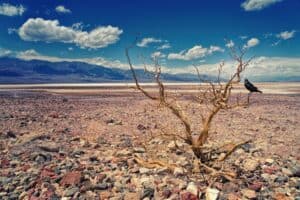Climate change is causing significant changes in weather patterns worldwide. The negative impacts cannot be overstated — melting glaciers, rising sea levels and temperatures, heat waves, and the loss of animal species. Another consequence of climate change is severe droughts, which scientists suggest can lead to mass deforestation, thereby making droughts even worse.
A drought describes a type of natural disaster where an environment is drier than usual. Areas suffering from a chronic lack of water — for days, months or years — have less moisture than under normal conditions.
The most damaging effects droughts have on the environment include poor water and air quality; shortages of drinking water; the spread of diseases; potential insect outbreaks; the destruction of aquatic species and their habitats; crop failures and food shortages; and an increased number of wildfires; and challenges to sanitation, hygiene and waste management services.
Deforestation, meanwhile, can be detrimental to entire ecosystems. It can lead to the extinction or endangerment of animals and plants; the release of large amounts of CO2 into the atmosphere; changes in rainfall and weather patterns; amd the destruction of natural landscapes, often beyond repair.
There’s no single reason why droughts and instances of deforestation occur. Rather, it’s a combination of factors that lead to these environmental changes.
The relationship between droughts and deforestation
How do droughts and deforestation relate to each other? Research suggests there’s a so-called “feedback loop” between the two. Droughts can lead to deforestation, and substantial deforestation can lead to long-term droughts in a given area.
One vulnerable region in the world facing droughts and deforestation is the Amazon rainforest. It suffers from reduced rainfall, which is critical for its survival when deforestation occurs.
Forest and rangeland ecosystems are subject to various physiological and structural changes in areas where seasonal droughts are common. Places where they’re less common cannot adapt to potential dry conditions. Droughts cause tree mortality under changing climatic conditions, making it nearly impossible for forests to expand and thrive in an ecosystem.

Some scientists believe human-caused deforestation disrupts and harms the environment so much that severe droughts are inevitable. Because trees play a significant role in the water cycle of an area, deforestation can cause floods and droughts. If there’s excess rainfall and not enough trees to act as sponges, the water cannot go underground, and floods occur. Without any precipitation, trees die.
In Africa, widespread deforestation is partially responsible for severe droughts. The continent is known to have fluctuating climate conditions, often going from dry to clammy. Kenya is one country impacted heavily by deforestation and suffers from long-term drought conditions.
The effects of climate change also impact the Guinea region and are directly related to deforestation. In 2019, farmers expressed frustration with the government because deforestation caused severe droughts affecting their harvests.
Logging forests in higher altitudes is causing a lack of rain, leading to droughts. This impacts farmers’ abilities to produce food for their communities and make a living.
In India, various regions suffer from severe droughts, such as West Bengal, Bihar and Jharkhand. These areas are densely populated, so the implications are far-reaching because of their negative socioeconomic impacts. From 2000 to 2019, more than a billion people in this one country alone were affected by droughts, the second-worst disaster after flooding.
At the same time, deforestation in one region can cause changes in weather patterns a long distance away. Cutting down trees in the Amazon, for instance, is causing droughts in the United States, especially in California, Texas and New Mexico.
Initiatives to stop deforestation
Deforestation is also an especially serious issue in nations such as Brazil and Indonesia. However, with effective policies it is possible to avoid deforestation and its negative impacts on the environment and public health.
As a bonus, there could be fewer droughts if deforestation stops. If droughts become less frequent, forests can survive, expand and cover more land. They can then provide essential resources, facilitate biodiversity, and sustain rural livelihoods and communities.
At the COP26 climate summit last year, more than world 100 leaders committed to ending deforestation by 2030. The pledge included $19.2 billion of public and private funds to end and reverse deforestation.
However, a similar initiative in 2014 failed to slow down deforestation. Therefore, some experts remain skeptical whether deforestation will ever truly cease until any trees are left.
One thing is for sure: as the drought-deforestation feedback loop continues contributing to the worsening of the natural environment we will need strong laws and meaningful actions to stop it once and for all.
Did you like it? 4.4/5 (29)








